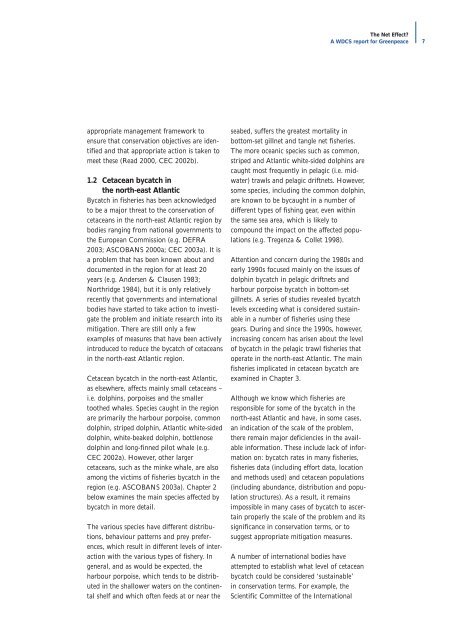The Net Effect? - Whale and Dolphin Conservation Society
The Net Effect? - Whale and Dolphin Conservation Society
The Net Effect? - Whale and Dolphin Conservation Society
You also want an ePaper? Increase the reach of your titles
YUMPU automatically turns print PDFs into web optimized ePapers that Google loves.
appropriate management framework to<br />
ensure that conservation objectives are identified<br />
<strong>and</strong> that appropriate action is taken to<br />
meet these (Read 2000, CEC 2002b).<br />
1.2 Cetacean bycatch in<br />
the north-east Atlantic<br />
Bycatch in fisheries has been acknowledged<br />
to be a major threat to the conservation of<br />
cetaceans in the north-east Atlantic region by<br />
bodies ranging from national governments to<br />
the European Commission (e.g. DEFRA<br />
2003; ASCOBANS 2000a; CEC 2003a). It is<br />
a problem that has been known about <strong>and</strong><br />
documented in the region for at least 20<br />
years (e.g. Andersen & Clausen 1983;<br />
Northridge 1984), but it is only relatively<br />
recently that governments <strong>and</strong> international<br />
bodies have started to take action to investigate<br />
the problem <strong>and</strong> initiate research into its<br />
mitigation. <strong>The</strong>re are still only a few<br />
examples of measures that have been actively<br />
introduced to reduce the bycatch of cetaceans<br />
in the north-east Atlantic region.<br />
Cetacean bycatch in the north-east Atlantic,<br />
as elsewhere, affects mainly small cetaceans –<br />
i.e. dolphins, porpoises <strong>and</strong> the smaller<br />
toothed whales. Species caught in the region<br />
are primarily the harbour porpoise, common<br />
dolphin, striped dolphin, Atlantic white-sided<br />
dolphin, white-beaked dolphin, bottlenose<br />
dolphin <strong>and</strong> long-finned pilot whale (e.g.<br />
CEC 2002a). However, other larger<br />
cetaceans, such as the minke whale, are also<br />
among the victims of fisheries bycatch in the<br />
region (e.g. ASCOBANS 2003a). Chapter 2<br />
below examines the main species affected by<br />
bycatch in more detail.<br />
<strong>The</strong> various species have different distributions,<br />
behaviour patterns <strong>and</strong> prey preferences,<br />
which result in different levels of interaction<br />
with the various types of fishery. In<br />
general, <strong>and</strong> as would be expected, the<br />
harbour porpoise, which tends to be distributed<br />
in the shallower waters on the continental<br />
shelf <strong>and</strong> which often feeds at or near the<br />
seabed, suffers the greatest mortality in<br />
bottom-set gillnet <strong>and</strong> tangle net fisheries.<br />
<strong>The</strong> more oceanic species such as common,<br />
striped <strong>and</strong> Atlantic white-sided dolphins are<br />
caught most frequently in pelagic (i.e. midwater)<br />
trawls <strong>and</strong> pelagic driftnets. However,<br />
some species, including the common dolphin,<br />
are known to be bycaught in a number of<br />
different types of fishing gear, even within<br />
the same sea area, which is likely to<br />
compound the impact on the affected populations<br />
(e.g. Tregenza & Collet 1998).<br />
Attention <strong>and</strong> concern during the 1980s <strong>and</strong><br />
early 1990s focused mainly on the issues of<br />
dolphin bycatch in pelagic driftnets <strong>and</strong><br />
harbour porpoise bycatch in bottom-set<br />
gillnets. A series of studies revealed bycatch<br />
levels exceeding what is considered sustainable<br />
in a number of fisheries using these<br />
gears. During <strong>and</strong> since the 1990s, however,<br />
increasing concern has arisen about the level<br />
of bycatch in the pelagic trawl fisheries that<br />
operate in the north-east Atlantic. <strong>The</strong> main<br />
fisheries implicated in cetacean bycatch are<br />
examined in Chapter 3.<br />
Although we know which fisheries are<br />
responsible for some of the bycatch in the<br />
north-east Atlantic <strong>and</strong> have, in some cases,<br />
an indication of the scale of the problem,<br />
there remain major deficiencies in the available<br />
information. <strong>The</strong>se include lack of information<br />
on: bycatch rates in many fisheries,<br />
fisheries data (including effort data, location<br />
<strong>and</strong> methods used) <strong>and</strong> cetacean populations<br />
(including abundance, distribution <strong>and</strong> population<br />
structures). As a result, it remains<br />
impossible in many cases of bycatch to ascertain<br />
properly the scale of the problem <strong>and</strong> its<br />
significance in conservation terms, or to<br />
suggest appropriate mitigation measures.<br />
A number of international bodies have<br />
attempted to establish what level of cetacean<br />
bycatch could be considered ‘sustainable’<br />
in conservation terms. For example, the<br />
Scientific Committee of the International<br />
<strong>The</strong> <strong>Net</strong> <strong>Effect</strong>?<br />
A WDCS report for Greenpeace<br />
7

















